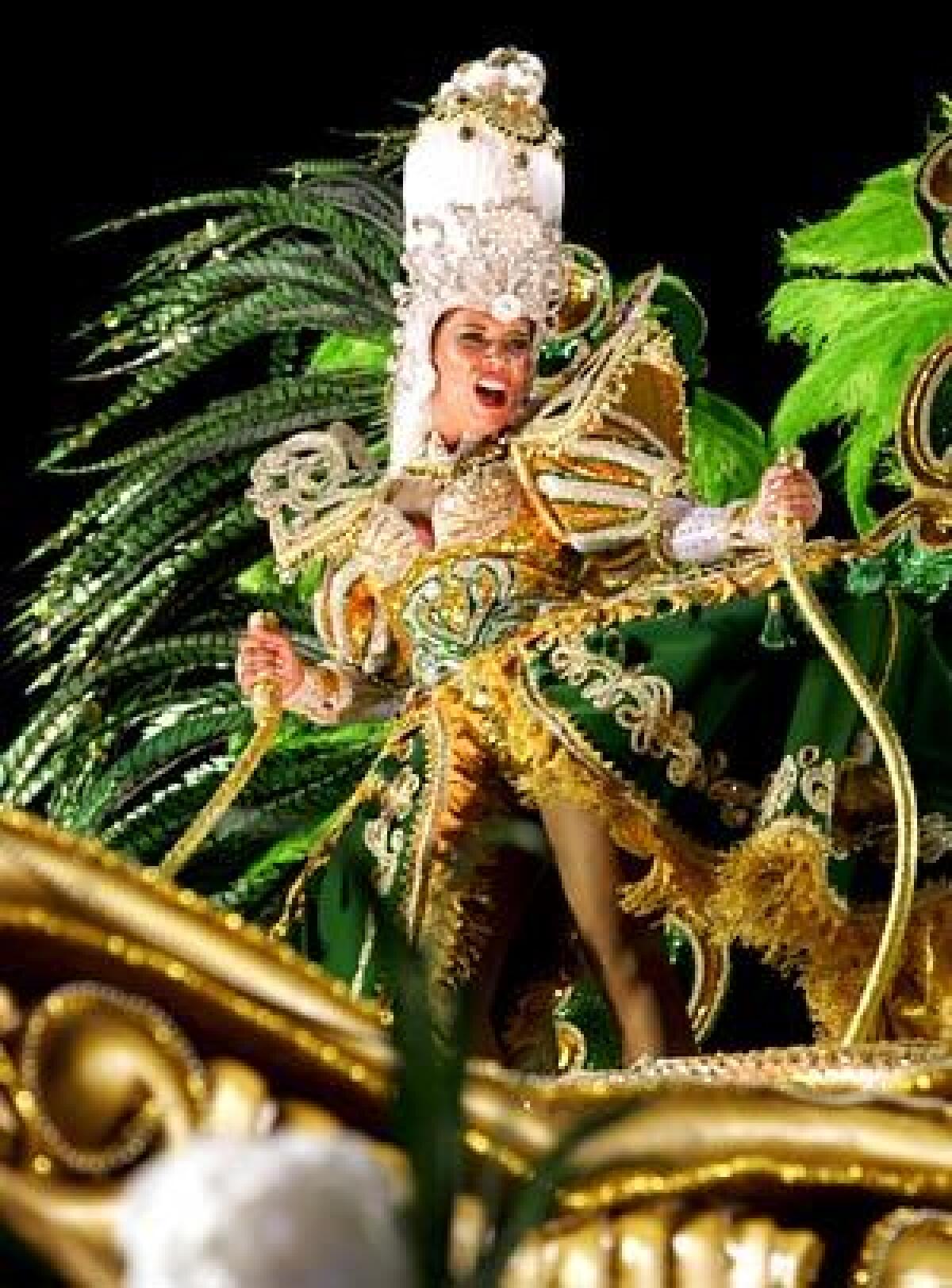A tourist and a participant in Brazil’s Carnival

- Share via
Reporting from Rio De Janeiro — It was near midnight and the rain-drenched streets had already stained my white satin slippers. A Napoleon-style hat, adorned with golden beads and white plumage, was perched precariously atop my head. Stepping delicately in my soggy shoes, I gripped my ruffled lace pant legs to keep them from dragging on the wet cobblestones.
“Qual escola de samba?” people called out in Portuguese as a crescendo of cheers echoed over the stadium walls. “Império da Tijuca!” we answered, shouting back the name of our samba school.
From their plastic chairs, squeezed between the beer coolers and hot dog vendors, those who couldn’t afford tickets to Rio de Janeiro’s Carnival competition packed Avenida Presidente Vargas to enjoy the camaraderie outside the Sambadrome. They stared with amusement as our group of gringos, sweating inside our polyester costumes, hurried past.
Among the eight of us, the Dutchman was tipsy and the Danish girls complained about the suffocating heat, but I didn’t care. I had made my pilgrimage to Carnival specifically to see the decadent display of dancers and floats parading in all their pageantry. For one month we’d volunteered with a Rio-based social service organization, which, for a fee, enrolled us with a samba school.
Now, I wouldn’t just watch a Carnival parade, I was about to be in one.
Each year, an estimated 500,000 foreigners revel in Rio during one of the sexiest celebrations on Earth. During the four party days (this year, Feb. 13-16) of “Carne Vale,” literally “farewell to flesh, or meat,” leading to Lent, all of Brazil seems to relish carnal pleasures before the deprivation.
Though I was born in Brazil, it wasn’t until I took samba dance classes in my 20s and later performed with an amateur troupe that I became smitten with my birth country and its sensuous samba, and I have been ever since.
For months before this trip, I’d pored over Internet videos of parades, mesmerized by the dancers who strutted through the Sambadrome in their bejeweled bikinis and peacock-feathered bodies. But any thought of portraying a sexy sambista was shattered when our costumes arrived at our guesthouse.
Sporting those tricorn hats and frumpy white suits with oversized plastic buttons, our section of the samba school would dress as students of the Royal Academy of Medicine, in honor of the first university established in Rio. Each samba school illustrates a theme, or enredo, through its song, floats and costumes, so ours would tell the story of the Portuguese royal court moving to Brazil to evade Napoleon 200 years before.
Once inside the gates of the half-mile-long venue, amid a flurry of feathers and fantasias, or costumes, I was engulfed by hundreds of winged creatures with headdresses molded into whimsical shapes. Lost between floats -- one depicting a large golden ship and another a tropical forest -- I was relieved to recognize this assemblage as Império da Tijuca, our samba school, distinguished by the gold-green hues of the ornate décor.
The queen of the bateria led hundreds of percussionists whose drumsticks blurred as fast as her feet. The passistas, or female samba dancers, laced up the knee-length gold straps of their plataforma sandals and shook their glittery hips in time to the tambourines.
Hearing the unmistakable call of the caixa drums, one Brazilian woman showed me her samba steps. All those years of dance lessons culminated in the moment when, to her delighted surprise, I copied her right back. Communicating playfully through our movements, we shared a common culture and a language beyond words.
Suddenly our director ushered all his Royal Medical students to the front of our float. “Make sure you stay in your lines of eight, just like you practiced in the rehearsal!” he commanded, running from side to side in an effort to herd our unit into a dozen perfect rows.
Judges would confer points on how well our school moved in formation and sang our samba song. If Império da Tijuca won tonight, it could move up to “special group” status to compete among the top 12 schools the following year. Even if we couldn’t remember all the words to our theme song, we were to mouth something with enthusiasm during our moments in the limelight.
Fireworks exploded into the night sky, signaling the start of our procession down the parade route. More than 70,000 spectators filled the concrete stands and box seats that ascended on each side of the Sambadrome under the blazing floodlights. The sardine-packed sea of bodies stretched its arms into the air, waving small flags in a show of support as we passed by.
Throughout our 40-minute march, there was no mistaking our contingent of tourists for the real thing. But it didn’t really matter. So what if my cumbersome costume more closely resembled the Michelin Man than any samba queen I’d envisioned emulating? Parading with thousands under a drizzling summer sky, I had experienced Rio’s Carnival at its core. I would return to the States feeling a deeper connection to my birth country. And I’d be sure to bring back a bit of that samba queen, along with my own pair of plataformas and a silver-sequined headdress.
More to Read
Sign up for The Wild
We’ll help you find the best places to hike, bike and run, as well as the perfect silent spots for meditation and yoga.
You may occasionally receive promotional content from the Los Angeles Times.






